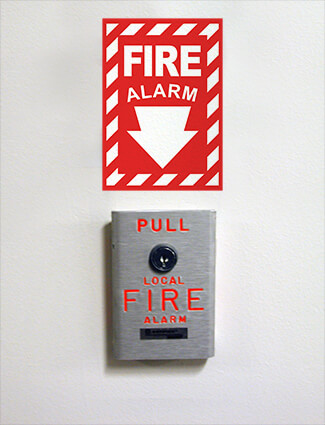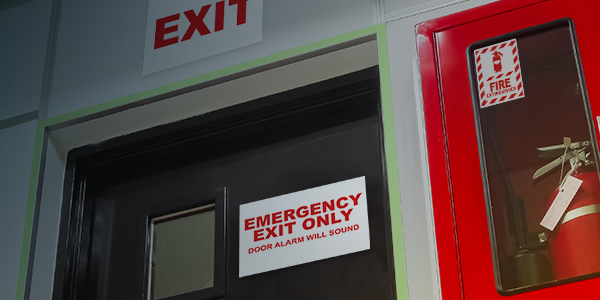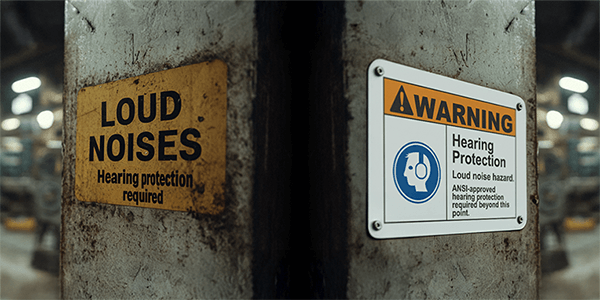Fire Signs

The most important signs are those indicating the means of escape, usually consisting of Fire Exit signs (with the 'running man' symbol) on or above designated final exits, and similar signs (with directional arrows if necessary) indicating the route to the final exit. These should be of appropriate size to be readily seen...
Fire signs are used to provide critical safety information needed during a fire emergency. They fall into a number of categories.
- Emergency exit route signs
- Signs identifying areas of refuge
- Signs that identify evacuation assembly points
- Fire door signs
- Signs that identify the location of fire extinguishers
- Signs showing the location of manual fire alarm call points
- Fire action signs
Fire Signs ? Emergency Exit Routes
In simple premises, a few signs indicating the alternative exit(s) might be all that is needed. In more complex premises, a series of signs directing people along the escape routes towards the final exit may be needed.
If there were a fire, how would you get out of your building? What if your planned route was blocked by the fire? Most workplaces are required by OSHA have at least two exit routes. Do you know how to get to an alternate emergency exit? What if you are in an unfamiliar part of the building?
If someone can be in a location in your building where they might not be sure how to get to an emergency exit, there should be a sign directing them. OSHA requires that: If the direction of travel to the exit or exit discharge is not immediately apparent, signs must be posted along the exit access indicating the direction of travel to the nearest exit and exit discharge. Additionally, the line-of-sight to an exit sign must clearly be visible at all times.
Of course, these fire signs must be visible, durable, and easy to understand. They should include both text and symbols so their message is understood without regard to the language a person speaks. They should never be blocked or obstructed. Their purpose is to direct people to emergency exits or areas of refuge.
Identifying an Area of Refuge (Shelter In Place)
Depending on the type of building, who is in the building, and the possible types of emergencies, areas of refuge may be supplied within the building. For example, in a large building in which many handicap people work, it may not be practical to evacuate people from some parts of a building. In that case, fire-proof areas of refuge will be available to protect people during the fire.
A circumstance in which normal rooms in a building might be used as areas of refuge would be the release of chemical, biological, or radiological contaminants near a business. For example, if there was a nearby derailment of a rail car transporting chlorine, it may be safer safer to remain in the building than to evacuate. The entire building may be used for people to shelter in place, or an interior portion of the building may be designated for sheltering.
When specific areas of refuge from fire have been established, fire signs are used to direct people to those areas, and to identify those areas. Once inside an area of refuge, signs should be posted telling people what to do, where supplies are located, and what needs to be done to seal the area against the fire.
When a facility is located such that there is the possibility of the need to shelter in place, signs are used to direct people to the locations they need to go to during a shelter in place emergency.
Identifying Evacuation Assembly Points
Being able to account for everyone following an evacuation is important. This allows emergency responders to know whether people needing rescue remain in the building. That's why, whenever there is an evacuation, people should go to an evacuation assembly point. Signs posed near fire exit discharge points should direct people to the nearest evacuation assembly point. In addition, the evacuation assembly point should be identified with prominent signs. As people come into the evacuation assembly point, they can be logged so that it is know they safely evacuated.
Fire Door Signs
There are three parts to an evacuation route. As defined by OSHA these are:
- Exit access ? portion of an exit route that leads to an exit.
- Exit ? portion of an exit route that is generally separated from other areas to provide a protected way of travel to the exit discharge.
- Exit discharge ? part of the exit route that leads directly outside or to a street, walkway, refuge area, public way, or open space with access to the outside.
The exit access is the pathway you follow to get from where you work to an exit. The exit may lead directly outside, or to an exit such as an enclosed stairway. That enclosed stairway will be protected by fire doors that are resistant to fire for a specified period of time. So, although you may not be outside, once you are in an exit you have some protection from a fire.
Two types of fire signs are needed for doors. One identifies a door as a fire door. It might say, for example:
FIRE DOOR ? KEEP CLOSED
The other type of sign is used to eliminate confusion and errors by warning people that a doorway is not an exit. That type of door sign will simply have the message:
NOT AN EXIT
Identifying the Locations of Equipment
Another important function of fire signs is to identify the location of fire equipment, manual alarm call locations, and the areas that emergency responders need to access.
Fire Equipment
Signs need to be used to direct people to the locations where they can get fire equipment, to identify that equipment, and to provide instructions in its use. This includes fire extinguisher locations, fire hose locations, and other emergency firefighting equipment. If people with minimal training will be using the equipment, such as an employee using a fire extinguisher, fire signs giving instructions on how to use the equipment should be provided.
Signs also need to be used to help emergency responders find what they need. For example, the following should be identified:
- Sources of fire water
- Emergency shut-off valves for natural gas, and other explosive or combustible substances
- Emergency shut-off switches for electrical power
- Shut-off valves for fire sprinkler systems
- Emergency triggers for fire sprinkler or CO2 systems
If fire signs are located in areas that may be dark at night, or during an emergency, consideration should be given to using DuraLabel phosphorescent signs. These are self-illuminating signs that do not require a power source. They make finding needed locations easier during both well-lite and totally dark conditions.
Manual Alarm Call Locations
When there is an emergency, some people tend to get nervous and may not be able to think clearly. Manual fire alarms should be clearly and boldly marked with signs so that they are easy to find and identify. People need to be able to find and actuate them in stressful conditions.
In addition, be sure that it is easy to find a fire exit from any manual fire alarm call point. If an exit is not close, use signs to direct people to the nearest emergency exit.
Fire Action Signs

A fire action sign provides instructions about what to do should there be a fire. They serve to help people remember what needs to be done, should they spot a fire. For example, a fire action sign might have three sections with the following instructions:
- Operate Nearest Fire Alarm
- Leave the building using nearest emergency exit
- Report to an assembly area
- Do not use elevator
Fire actions signs might include emergency phone numbers, information about responding should you hear a fire alarm, and a list of the equipment that needs to be shut down. The instructions on a fire action sign will be specific for the people working in a location.
Fire action signs are not required by OSHA.
Your Best Source Of Fire Signs
As you can see, a variety of fire signs are needed. Some are generic, and some are very specific to the situation. In either case, the best option for making fire signs is a DuraLabel sign printer. With DuraLabel you can economically print however many generic signs you need. You also can easily print individual, customized signs. Your signs can be made using any of more than 50 types of supplies, including DuraLabel's phosphorescent materials, or tough-tested DuraLabel vinyl ? the only vinyl that gives you a warranty on your signs after they've been put in place. With that type of material selection, you can always get the right supplies to do the job right.
Related Resources

OSHA Fire Readiness Essentials for Any Workplace
What Are Fire Safety Procedures and Why Do They Matter in the Workplace? Fire safety remains a critical ...
Read
5 Ways to Make Workplace Safety Signs Stand Out
How Safety Signage Improves Hazard Communication and Employee Awareness Workplace safety signs play a key ...
Read
Understanding OSHA Citations: Common Violations and Penalties
OSHA citations are routinely given to companies throughout the United States. Organizations large and small ...
Read.png)





